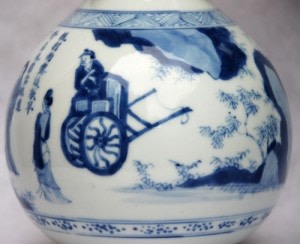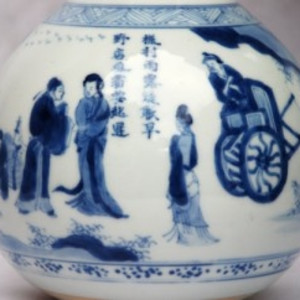Further images
Of Islamic shape, with a globular body, rounded base, tubular neck and flanged lip and collar, painted in shades of underglaze blue with a continuous scene of figures in a landscape, a man and woman, both dressed in long robes, stand facing each other in conversation, to the side of the man another male figure is seated next to wrapped possessions, a saddled horse nearby, behind the lady two further figures, one a female turned towards the conversing pair, the other a man seated in a carriage, above in the sky a formation of birds in flight, between the two ladies a two-line inscription, finely painted trees and branches with stylized rock-work line the scene, set in between a band of triangle-work on the shoulder and a thin band with small dotted clusters above the foot, the neck with stylized pendant leaves below the flanged collar with a cafe-au-lait rim and further triangle-work, single stylized flowers on the top part of the tubular neck and finished on the flanged lip with a decoration of small blue lines surrounded again by a cafe-au-lait glazed rim, the lowest part of the body unglazed, forming a convex base, unglazed apart from a small glazed circular recessed area.
Provenance
The Inder Rieden Collection
Literature
An interpretation of the inscription would read: It is wet and gloomy in the evening so good time to sleep early in a little inn in the wilds...it's bathed in the morning dew...right time to rise late.
An example of the same shape and same period but in famille verte enamels, decorated with stylised Islamic calligraphy, is in the British Museum, no. 1956, 1017.2, donated to the museum by R Soames Jenyns and exhibited in the museum's exhibition "Fascination with Nature" 10th January to 5th August 2008. Two further examples in the collection of the Victoria & Albert Museum, one decorated with floral garlands in underglaze blue, originally bought in Iran, museum no. 1596-1876, the other from the Salting Bequest decorated in a cafe-au-lait glaze with blue and white medallions, museum no. C.959-1910.
Another example in underglaze blue and white of the same form is in the collection of the Topkapu Saray Palace, TKS 15/4312, illustrated in John Ayers, Regina Kraahl and others, Chinese Ceramics in the Topkapu Saray Museum, Istanbul, London, 1986. 3 quarto vols., pl. 2084, p. 987.






